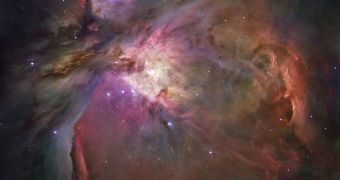The Orion Nebula Cluster is relatively close by, at about 1350 light years away, and can be seen with the naked eye in the night sky. While it's one of the most observed objects in the sky, there are plenty astronomers still trying to figure out about it.
One team has been using computer simulations to try and explain the erratic movements of the stars in the nebula and the peculiar distribution.
What they found was that the only explanation for the nebula's current state is a stellar mass black hole in its center. The nebula was formed one or two million years ago and is a busy place.
The stars inside move at a very fast pace so fast that they shouldn't be staying inside the nebula for long.
What's more, there's an unusually small number of large stars compared to low mass ones, and the large stars that can be found move faster than they should.
All of this is explained by a black hole roughly 200 times as heavy as the sun which sits in the middle and keeps the entire thing from spinning itself apart.
The gravitational pull from this black hole ensures that the stars can move as fast as they do and still remain in orbit around it.
What's more, it provides an explanation for the small number of large stars as well. Astronomers believe that early in the nebula's history its expansion accelerated star movement.
The big ones were shot out of the nebula, but some converged to the center and began to merge into one star.
This happened until this start became too massive to support itself and collapsed into a black hole, the one that is keeping the system together now. The results of this research have been published in the Astrophysical Journal.

 14 DAY TRIAL //
14 DAY TRIAL //